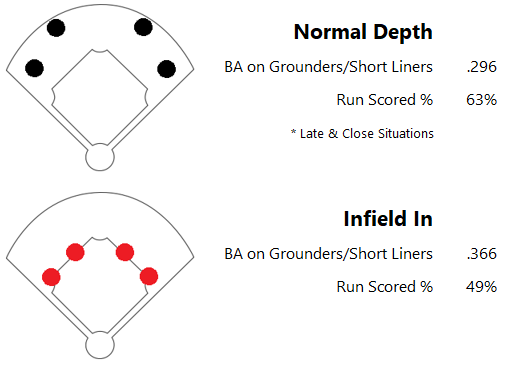By ANDREW KYNE
Since 2015, Baseball Info Solutions has tracked situational defensive alignments like “infield in” and the rare five-infielder defense, among several other variations.
The “infield in” strategy is particularly interesting. You might hear commentators mention how substantially batting averages increase when the infielders are all pulled in. But what do the numbers show?
First, let’s consider groundballs and short line drives (since those are the types of balls in play affected by the infield’s alignment here) hit against “infield in” alignments with fewer than two outs since the beginning of 2015. The batting average on those balls in play: .366.
The overall goal in these situations, though, is to cut down the runner scoring from third. On grounders and short liners with the infield in, the batting team scored at least one run 49% of the time.
Now, how does that compare to when the defense plays a traditional alignment in similar game contexts?
Let’s consider grounders and short liners hit against a normal infield defense in similar situations where it would be beneficial to prevent the runner on third from scoring: seventh inning or later; tied or one-run game; fewer than two outs with a runner on third (and possibly second, but not first — so a double play is not in order). Because that’s not the most common situation (only 35 since the start of 2015), we’ll take any of these late-and-close balls dating back to 2010.
In those situations, batters hit .296 on grounders and short liners — about 70 points worse than against a drawn-in infield.
However, the batting team scored at least one run on 63% of these plays — compared to 49% with the infield in.

So, there’s clearly a trade-off here for the defense. Bringing the infield in will increase the likelihood of a hit on a groundball or short line drive, as the infielders have less time to react. But playing the infield in will do a better job of preventing runs. Even regular groundouts can score the runner when the infield is back; meanwhile, a ball fielded in a drawn-in infield can stop the runner from trying to score, or he can be more easily thrown out at home.
In 2018, the teams that played the most balls in play with “infield in” were the Padres (98), Phillies (93), and White Sox (82). The teams that played the fewest were the Angels (32), Brewers (32), and Mariners (34).


